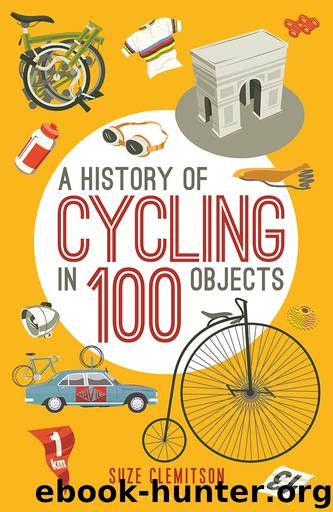A History of Cycling in 100 Objects by Suze Clemitson

Author:Suze Clemitson
Language: eng
Format: epub
ISBN: 9781472918895
Publisher: Bloomsbury Publishing
Published: 2017-06-15T00:00:00+00:00
The Vélib’ bicycle-sharing scheme was launched in Paris in 2015. The Vélib’ is the clean, green and healthy way to get around the French capital.
50
Home trainer
The sight of professional riders warming up and cooling down on stationary bikes is now a familiar one, and both pro and keen amateur cyclists alike have long spent their winter months keeping fit on indoor cycling devices such as rollers and turbo trainers.
The first rudimentary bicycle trainer actually pre-dates the first bicycle. Called the Gymnasticon, it was invented in 1796 by Englishman Francis Lowndes – a pioneer in the field of medical electricity as a therapy and cure for injury and disease – to exercise the joints and muscles, and consisted of two large wheels mounted on a frame and propelled by hand cranks and foot treadles.
Bicycle trainers based on the high-wheeler and safety bicycles were already in use when Albert Schlock, an American who rode the US and European six-day circuits, developed his training wheel in the 1890s, on which he claimed to be able to cover a mile in less than three minutes. Schlock’s trainer, essentially a saddle mounted on a pedal-driven flywheel, was the precursor of exercise bicycles familiar in any modern gym.
Another early type of stationary bicycle, the ergometer, was developed with the specific purpose of testing a user’s work rate rather than just as a training vehicle. Refined in the 1950s, they were in common use in the 1970s as a way of measuring a cyclist’s power output and heart rate and are still used in sports physiology labs. Rollers, devices that typically consist of a system of three rollers held in a frame on which a rider balances their bike and cycles, have also been popular since the height of the bicycle boom at the end of the 19th century. Both the turbo and roller styles of home trainer allow cyclists to exercise indoors without the distraction of other road users. Whereas the turbo trainer builds strength and power by working against resistance, rollers force a rider to focus on cadence and technique.
Another variation on indoor training is the spin bike. Developed by keen endurance cyclist Jonathan Goldberg, the spin bike made its debut in the 1990s and represents the culmination of his quest to develop a home-trainer that more closely replicated what happened on the open road. A fixed-gear stationary bike with a weighted flywheel and adjustable tension, the spin bike can simulate climbing as well as riding flat, and soon became an exercise phenomenon. Goldberg opened his first spin studio in a disused garage in California in 1987, and just a year later more than a million people had taken part in a spin class at their gym. By 1993, Rolling Stone magazine was calling spinning the ‘hot’ new exercise craze.
The most recent arrival on the stationary bike scene is Rollapaluza. This jazzily named machine has revived the sport of indoor roller racing and involves two or more competitors racing each other on stationary bikes in timed events.
Download
A History of Cycling in 100 Objects by Suze Clemitson.epub
This site does not store any files on its server. We only index and link to content provided by other sites. Please contact the content providers to delete copyright contents if any and email us, we'll remove relevant links or contents immediately.
| Bike Repair | Excursion Guides |
| Mountain Biking |
Shoe Dog by Phil Knight(5114)
The Rules Do Not Apply by Ariel Levy(4830)
Walking by Henry David Thoreau(3881)
How to Read Water: Clues and Patterns from Puddles to the Sea (Natural Navigation) by Tristan Gooley(3389)
Running Barefoot by Amy Harmon(3389)
I'll Give You the Sun by Jandy Nelson(3345)
Crazy Is My Superpower by A.J. Mendez Brooks(3320)
How to Read Nature by Tristan Gooley(3234)
How Music Works by David Byrne(3161)
The Boy, the Mole, the Fox and the Horse by Charlie Mackesy(2984)
The Fight by Norman Mailer(2838)
Seducing Cinderella by Gina L. Maxwell(2599)
Cuba by Lonely Planet(2570)
Accepted by Pat Patterson(2293)
Going Long by Editors of Runner's World(2287)
The Unfettered Mind: Writings from a Zen Master to a Master Swordsman by Takuan Soho(2239)
Backpacker the Complete Guide to Backpacking by Backpacker Magazine(2186)
The Happy Runner by David Roche(2185)
Trail Magic by Trevelyan Quest Edwards & Hazel Edwards(2117)
